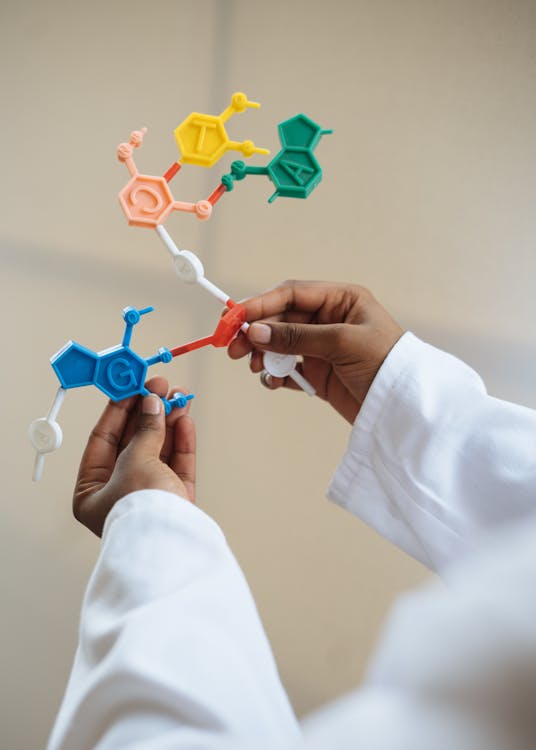Introduction
Oligonucleotides—short, synthetic DNA or RNA sequences—have revolutionized molecular biology, diagnostics, and therapeutics. From PCR primers to antisense therapies, these versatile molecules serve countless applications in research and medicine. This article provides a comprehensive introduction to oligonucleotide synthesis, covering fundamental concepts, methodologies, and applications for researchers and professionals new to the field.
Fundamentals of Nucleic Acid Chemistry
Before diving into synthesis methods, it's essential to understand the basic structure of nucleic acids:
Basic Building Blocks
Nucleic acids consist of three primary components:
- Nucleobases: The nitrogenous bases adenine (A), guanine (G), cytosine (C), thymine (T, in DNA), and uracil (U, in RNA) that form the genetic code through specific base pairing (A-T/U and G-C).
- Sugar: A pentose sugar—deoxyribose in DNA and ribose in RNA—that forms the backbone of the molecule.
- Phosphate Group: Connects sugar molecules, forming phosphodiester bonds that create the sugar-phosphate backbone.
Directionality and Nomenclature
Nucleic acids have inherent directionality:
- 5' and 3' Ends: Referring to the carbon positions on the sugar molecule. Synthesis proceeds from the 3' to 5' direction (opposite to natural biosynthesis).
- Sequence Notation: By convention, sequences are written from 5' to 3' left to right (e.g., 5'-ATGC-3').

Evolution of Synthesis Methodologies
Oligonucleotide synthesis techniques have evolved significantly over the past decades:
Historical Development
Key milestones include:
- 1950s-1960s: Solution-phase synthesis methods developed by Todd, Khorana, and others using phosphodiester and phosphotriester approaches.
- 1970s: Introduction of solid-phase synthesis by Letsinger and subsequent development of phosphite triester chemistry.
- 1980s: Development of phosphoramidite chemistry by Caruthers, which remains the dominant method today.
- 1990s-Present: Refinement of automated synthesis platforms, development of modified nucleosides, and scaled-up manufacturing processes.
Current Dominant Method: Phosphoramidite Chemistry
The phosphoramidite method has become the standard for oligonucleotide synthesis due to its:
- High coupling efficiency (>98% per cycle)
- Rapid reaction kinetics
- Compatibility with automation
- Versatility for incorporating modified nucleosides
- Scalability from research to commercial production
The Phosphoramidite Synthesis Cycle
Modern solid-phase synthesis using phosphoramidite chemistry involves a cyclic process with four key steps:
Step 1: Deprotection
The synthesis begins with a solid support (typically controlled pore glass or polystyrene) with the first nucleoside attached. The 5'-OH group is protected with a dimethoxytrityl (DMT) group that must be removed to expose the reactive hydroxyl:
- Accomplished using a mild acid (typically trichloroacetic acid or dichloroacetic acid)
- The colored DMT cation released can be quantified to monitor synthesis efficiency
- This step activates the growing chain for the next coupling reaction
Step 2: Coupling
A phosphoramidite nucleoside (with protected 5'-OH) is activated and coupled to the free 5'-OH of the growing chain:
- Activation occurs via a tetrazole or similar activator that protonates the diisopropylamino group
- The activated phosphoramidite reacts rapidly with the free 5'-OH
- Forms a phosphite triester linkage between nucleosides
- Typically achieves >98% efficiency in modern systems
Step 3: Capping
Any unreacted 5'-OH groups are blocked to prevent deletion mutations in the final product:
- Accomplished using acetic anhydride and N-methylimidazole
- Creates acetylated failure sequences that won't participate in subsequent cycles
- Critical for maintaining high product purity
Step 4: Oxidation
The phosphite triester linkage is oxidized to a more stable phosphate triester:
- Typically using iodine in water/pyridine/THF
- Converts the P(III) linkage to a P(V) phosphate
- Creates the phosphodiester backbone characteristic of nucleic acids
- Alternative reagents can create modified backbones (e.g., sulfurizing agents for phosphorothioates)
This four-step cycle is repeated for each nucleotide addition, building the oligonucleotide from 3' to 5'. After the final cycle, the completed oligonucleotide undergoes deprotection and cleavage from the solid support.
"The elegance of phosphoramidite chemistry lies in its simplicity and adaptability. From a four-step cycle, we can create virtually any sequence, incorporate a vast array of modifications, and scale from micrograms to kilograms."
— Dr. Julia Park, Head of Research & Development, Girindus
Post-Synthesis Processing
After synthesis completion, several critical steps are required:
Cleavage and Deprotection
The oligonucleotide must be removed from the solid support and all protecting groups removed:
- Base Deprotection: Typically using concentrated ammonia or ammonia/methylamine mixtures to remove nucleobase protecting groups.
- Phosphate Deprotection: Removal of cyanoethyl groups from the phosphate backbone, often occurring concurrently with base deprotection.
- 2'-OH Deprotection (RNA): For RNA oligonucleotides, additional steps are required to remove 2'-OH protecting groups, typically using fluoride reagents.
Purification Methods
Several techniques are available for purifying oligonucleotides:
- HPLC: Primarily reversed-phase and anion-exchange chromatography, offering high resolution and purity.
- Polyacrylamide Gel Electrophoresis (PAGE): Excellent separation based on length, particularly valuable for longer sequences.
- Cartridge-Based Methods: Reversed-phase cartridges for rapid purification of smaller quantities.
- DMT-On/Off Strategies: Leveraging the hydrophobicity of the DMT group for simplified purification protocols.
Analysis and Quality Control
Critical analytical methods include:
- Mass Spectrometry: For molecular weight confirmation and impurity identification.
- HPLC: For purity assessment and impurity profiling.
- Capillary Electrophoresis: For high-resolution analysis of length and purity.
- UV Spectrophotometry: For concentration determination based on nucleobase absorbance at 260 nm.
- Functional Testing: Application-specific assays to confirm activity.

Modified Oligonucleotides
One of the greatest advantages of chemical synthesis is the ability to incorporate modifications:
Backbone Modifications
Alterations to the phosphodiester backbone can enhance stability and pharmacokinetic properties:
- Phosphorothioates: Sulfur replacement of a non-bridging oxygen, improving nuclease resistance and often used in therapeutic oligonucleotides.
- Phosphorodithioates: Both non-bridging oxygens replaced with sulfur, offering enhanced stability.
- Methylphosphonates: Neutral backbone modifications with improved cell permeability.
- Peptide Nucleic Acids (PNAs): Peptide-based backbone replacing the sugar-phosphate structure entirely.
Sugar Modifications
Alterations to the ribose or deoxyribose sugar affect conformational properties and stability:
- 2'-O-Methyl: Enhanced nuclease resistance and binding affinity.
- 2'-Fluoro: Improved binding affinity and nuclease resistance.
- Locked Nucleic Acids (LNAs): Methylene bridge between 2'-O and 4'-C positions, dramatically increasing binding affinity.
- 2'-O-Methoxyethyl (MOE): Enhanced binding and pharmacokinetic properties, widely used in therapeutics.
Base Modifications
Modified nucleobases provide additional functionality:
- 5-Methyl cytosine: Mimics natural methylation patterns.
- Fluorescent Labels: Various dyes for detection in diagnostic applications.
- Biotin and Digoxigenin: For affinity capture and detection.
- Cross-linking Agents: For studying nucleic acid-protein interactions.
Terminal Modifications
Modifications at the 5' or 3' ends enable additional functionalities:
- Phosphorylation: Addition of phosphate groups for enzymatic reactions.
- Conjugation Points: Amino, thiol, or click chemistry handles for attaching other molecules.
- Cholesterol and Lipophilic Groups: Enhancing cellular uptake.
- Polyethylene Glycol (PEG): Improving pharmacokinetic properties.
Scale-Up Considerations
Transitioning from research scale to larger production presents challenges:
Research Scale (μmol)
Typical features of small-scale synthesis:
- Standard automated synthesizers (0.05-1 μmol scale)
- Column-based solid supports
- Standard reagent concentrations
- Simple purification methods (cartridge or HPLC)
Intermediate Scale (mmol)
Moving to larger scale requires adjustments:
- Specialized synthesizers with larger columns
- Optimized reagent concentrations and delivery
- Enhanced temperature and reaction time control
- Scaled purification methods (preparative HPLC)
Large Scale (mol)
Commercial production demands significant adaptations:
- Custom reactors designed for large-scale synthesis
- Specialized solid supports with optimized loading
- Continuous flow processes in some applications
- Industrial-scale purification systems
- Stringent quality control and process validation
- GMP compliance for therapeutic applications
Applications of Synthetic Oligonucleotides
The versatility of oligonucleotides enables a wide range of applications:
Research Tools
Fundamental applications in molecular biology:
- PCR Primers: Enabling DNA amplification for countless applications.
- Sequencing Primers: For traditional and next-generation sequencing methods.
- CRISPR Guide RNAs: Directing gene editing with precision.
- Probes for Hybridization: In applications like FISH, Northern/Southern blotting, and microarrays.
- Site-Directed Mutagenesis: For protein engineering and functional studies.
Diagnostic Applications
Critical components of modern diagnostic platforms:
- qPCR Probes and Primers: For quantitative detection of nucleic acids.
- Microarray Oligonucleotides: Enabling high-throughput genomic analysis.
- NGS Library Preparation: Adapters and barcodes for sequencing applications.
- Molecular Beacons and FRET Probes: For real-time detection with high specificity.
- Aptamers: Nucleic acid-based binding molecules for protein detection.
Therapeutic Applications
An expanding field with multiple modalities:
- Antisense Oligonucleotides: Targeting mRNA to modulate gene expression.
- siRNA and miRNA: Harnessing RNA interference pathways.
- Aptamers: As targeted therapeutic agents.
- mRNA Therapeutics: Synthetic mRNA for protein replacement and vaccines.
- CRISPR Components: For therapeutic gene editing approaches.
- Antigens for Vaccines: Including DNA vaccines and adjuvants.
Emerging Applications
Innovative uses continue to develop:
- DNA Nanotechnology: Creating precise structures through designed DNA interactions.
- DNA Data Storage: Utilizing oligonucleotides as a dense, stable information storage medium.
- Synthetic Biology: Building blocks for artificial genetic systems and gene circuits.
- Cell-Free Protein Synthesis: Templates for in vitro protein production.
Future Directions
Several trends are shaping the future of oligonucleotide synthesis:
Technological Innovations
- Enzymatic Synthesis Methods: Potential alternatives to chemical synthesis for specific applications.
- Flow Chemistry: Continuous manufacturing approaches for improved efficiency and scalability.
- Automation and Robotics: Enhanced throughput and reduced human intervention.
- Microfluidic Approaches: Miniaturized synthesis platforms with reduced reagent consumption.
Novel Delivery Strategies
- Advanced Conjugation Chemistry: For tissue-specific targeting and enhanced uptake.
- Nanoparticle Formulations: Improved delivery vehicles for therapeutic oligonucleotides.
- Cell-Penetrating Peptides: Enhancing cellular entry of oligonucleotide therapeutics.
Environmental Considerations
- Green Chemistry Approaches: Reducing organic solvent use and hazardous waste.
- Recyclable Solid Supports: Minimizing environmental impact of large-scale synthesis.
- Alternative Protecting Groups: Developing more environmentally friendly protection strategies.
Conclusion
Oligonucleotide synthesis has evolved from a specialized laboratory technique to a robust industrial process that enables countless applications in research, diagnostics, and therapeutics. The fundamental principles of phosphoramidite chemistry continue to serve as the foundation for most synthesis approaches, while ongoing innovations address challenges in scale, efficiency, and specialized applications.
At Girindus, we leverage decades of experience in oligonucleotide synthesis to provide high-quality products for a range of applications. Our expertise spans from specialized research oligonucleotides to large-scale GMP production for therapeutic development, employing state-of-the-art technologies and rigorous quality control to meet the diverse needs of our clients.
As the field continues to advance, we remain committed to pushing the boundaries of what's possible in oligonucleotide synthesis, enabling the next generation of discoveries and therapies that will shape the future of medicine and biotechnology.




